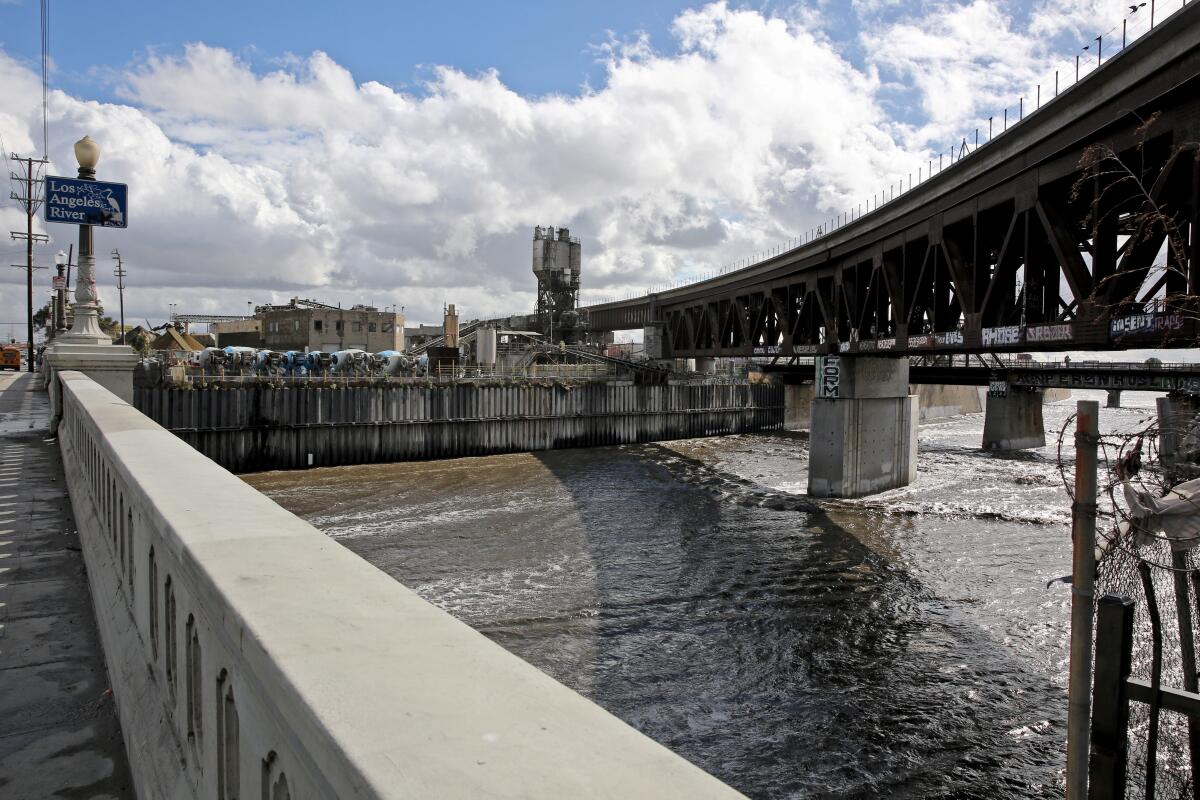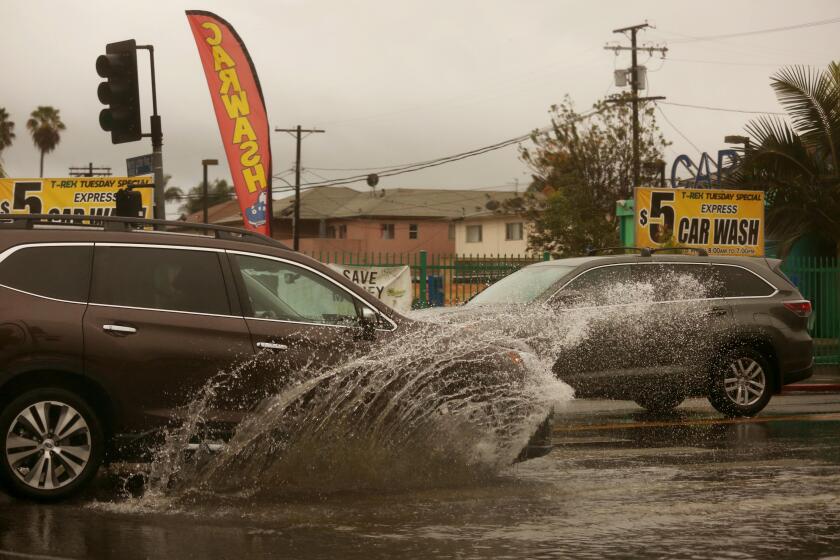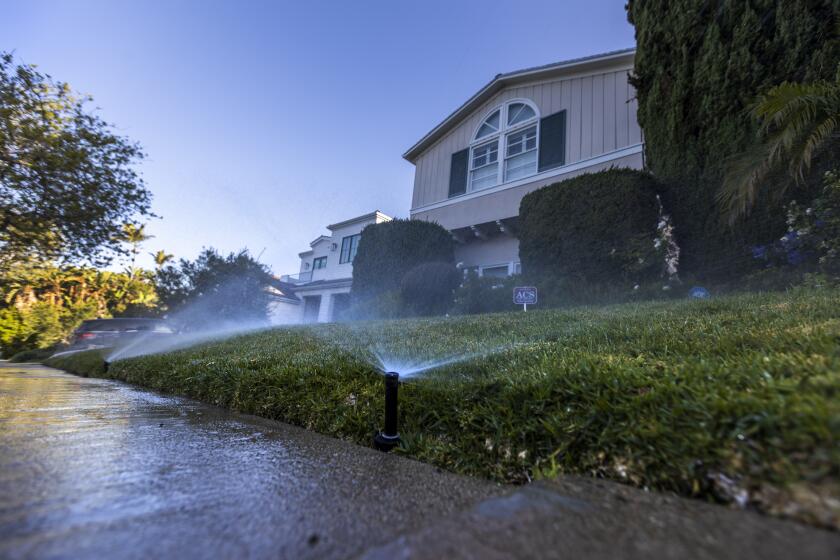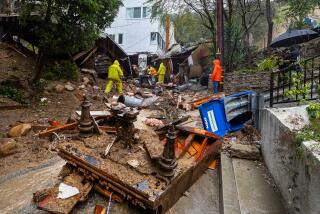One dead and four missing after being swept away by floodwaters amid record rainfall in Ontario

- Share via
One person is dead and four others missing after at least 10 were swept away by floodwaters in Ontario during a storm that pounded Southern California on Tuesday.
Five people were rescued and an unidentified man was found dead in the drainage basin after floodwaters swept out a group of people about 9:45 a.m. in the 1200 block of East 4th Street, according to Ontario Fire Chief Ray Gayk. Missing-person reports have been filed with the Ontario Police Department for two of the four people who are unaccounted for.
“As far as we know, there were homeless people in the storm drains and that’s when they got washed away by the surge of water and they ended up in the actual storm drain system,” Gayk said.
Randy Tomes, 31, said he has been homeless since he was 17 and he previously stayed at the channel by John Galvin Park where the people were swept away Tuesday.
The area was usually dry, Tomes said. He had been sleeping near a car wash in the area when he awoke to police sirens during the storm.
“They’re all my friends,” Tomes said. “They got swept away.”
A flash-flood warning meant for about 1,500 people in the Fish fire burn area was sent throughout L.A. County, the National Weather Service said. Stormwater swept away a group of people in Ontario.
The man who was found dead was a father in his 60s, according to Tomes.
“The city lost a father,” he said. “He was a good man.”
The flood control channel was locked and secured with signage and gates, but people still managed to get through, said Gayk, who added that Baker Avenue has been closed during the recovery mission.
“It’s an example of the dangers of what’s in these flood control basins,” Gayk said. “There’s a lot of debris, a lot of unpredictable water flows. These are just extremely dangerous areas.”
Miguel Batease, 26, looked out onto the water near Philadelphia Street and Baker Avenue, where authorities had cordoned off the area during their search.
Batease said his sister-in-law, Josephine Dominguez, 28, wasn’t homeless but had known some of the people who were living in the channel and went to speak with them Tuesday during the storm. He said their family hasn’t heard from her in two days.
“She would go to where all the homeless people are to speak the word of God,” he said. “It’s very unfortunate. When Mother Nature comes, there’s no fighting it. It’s very sad.”
The storm doused Los Angeles International Airport with 1.44 inches of rain, breaking the previous record of 1.3 inches set in 1998, according to the National Weather Service. In Burbank, 1.31 inches fell, surpassing the 1979 record of 0.66 of an inch. Long Beach received 0.86 of an inch of rain, breaking its record of 0.85 of an inch set in 1998. Lancaster and Palmdale also saw their records broken, receiving 0.57 of an inch of rain and 0.38 of an inch, respectively, surpassing their previous records of 0.4 of an inch and 0.22 of an inch.
The storm, which began to taper off Wednesday, originated from the Gulf of Alaska and was driven by a low-pressure system off the coast, according to the weather service. It dropped at least an inch of rain in most spots in Southern California, with mountain areas receiving a couple inches of rain, and snow at higher elevations.
Voters brave the rain to cast ballots in a midterm election that will determine which party controls Congress, abortion access and L.A.’s next mayor.
Temperatures were 10 to 15 degrees below normal Wednesday, with chilly nights expected for the next few days, according to the weather service. Developing Santa Ana winds are expected to peak Thursday in the Santa Lucia Range in San Luis Obispo County and Friday morning across the valleys in Los Angeles and Ventura counties, bringing gusty and cool winds to the region.
A freeze warning is in effect from Wednesday at midnight through 9 a.m. Thursday for the Antelope Valley and San Luis Obispo County interior valleys, including Lancaster, Palmdale, Carrizo Plain, Creston and Shandon, according to the weather service. Temperatures as low as 27 degrees are expected. Officials have warned residents to protect plants and animals from the cold and take time to defrost windshields.
“This was the most significant storm we’ve seen this year so far, and it was noteworthy since it’s early,” said Kristen Stewart, a meteorologist with the National Weather Service in Oxnard. “We usually see more significant rain in the January, February and March timeframe.”
The storm prompted L.A. County public health officials to issue a warning Wednesday against coming into contact with ocean water in the area.
From June through September, Los Angeles Department of Water and Power customers used 6 billion gallons of water less than during the same period last year.
“Bacteria, chemicals, debris, trash, and other public health hazards from city streets and mountain areas are likely to contaminate ocean waters at and around discharging storm drains, creeks, and rivers after a rainfall,” the county Department of Public Health said. “Individuals who enter the water in these areas could become ill.”
The warning will be in effect at least until noon Saturday and may be extended if there is additional rain, officials said.
A flash flood warning was mistakenly sent out by the weather service to a far larger area than intended Tuesday. The warning, which was meant for about 1,500 people in the Fish fire burn area east of Duarte, went wide when a “glitch” changed the small, targeted area to all of L.A. County, according to the National Weather Service. The warning was canceled, and a corrected warning was sent to those in the burn scar area.
Heavy snowfall and power outages prompted the Bear Valley Unified School District to close its schools Wednesday, according to a district news release.
Mammoth Mountain reported Wednesday receiving more than 2 feet of snow in the storm. The ski resort is still open Wednesday and has five of 25 lifts open.
It’s chilly out. To warm up, turn on the stove and make these bubbling pots of soups and stews.
It will take more storms to put a dent in California’s ongoing drought, which is entering its fourth year in a row. The state is grappling with its driest three-year period on record, and long-range forecasts have suggested that drier-than-average conditions are expected to continue this water year, which began Oct. 1.
“Any rainfall early in the water year is good for us to start alleviating the drought,” Stewart said. “The earlier the rainfall starts, the earlier it can start filling reservoirs and the snowpack in the Sierra. We haven’t had a huge fire season this summer and into the fall, so this early-season rain will help us with any Santa Ana events and alleviate potential for fire later on.”
A wet start to the water year but drier weather later on could also mean that next fire season could start earlier than expected, as it did last year, Stewart said.
“It really depends on how the rest of the year pans out,” she said.
Times staff writer Gregory Yee contributed to this report.
More to Read
Sign up for Essential California
The most important California stories and recommendations in your inbox every morning.
You may occasionally receive promotional content from the Los Angeles Times.















